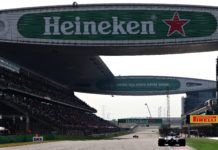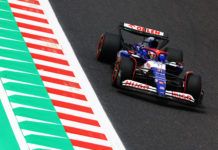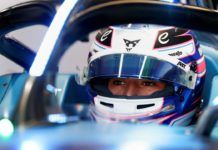Chief Technical Officer James Allison gives a lowdown of the F1 British GP starts from Mercedes drivers plus adds on the minor damage of Lewis Hamilton and his penalty.
The highly talked about F1 British GP had several more moments than the ones discussed so far, with Mercedes CTO, Allison, starting with an explanation on the race starts from Hamilton and Valtteri Bottas in Sprint Qualifying, as well as, the main event.
Allison agrees that the start from Hamilton and also Bottas on Saturday was not hugely optimal, where Red Bull’s Max Verstappen clearly had a better one to take the lead. In a weekend where overtaking was difficult, the race starts played an important role.
The subsequent Sunday start was better which allowed Hamilton to fight Verstappen, but it ended at Copse corner with the collision. The Brit suffered relatively minor damage, which could be fixed up with some tape, not even requiring a new front wing.
There was not a huge performance loss on his side, but the 10s time penalty did play a role, where Mercedes had to change their approach and strategy to cover the lost time. Allison, though, did not agree with the penalty as he deemed it as a racing incident.
Here’s excerpts from Allison in the usual post-race Mercedes debrief:
On race starts:
Allison: “I wouldn’t take the premise of this question exactly as it is meant because we didn’t have poor starts across the weekend as in every start was poor. In fact, if you looked at Lewis’s start in the main event at the start of the Grand Prix, that was a pretty useful start but it was definitely not one of our better weekend for starts. We were certainly far more hit and miss than we would like to be.
“If you look at our performance in starts as a whole, we are normally one of the better teams and so this weekend was a little disappointing. Starts are complicated and getting everything right so that the start works exactly as it should do, metronomically every single time with the best and most high performance start possible is a very difficult thing to achieve. It’s what we strive to achieve of course, but sometimes we don’t get it right in every aspect.
“I think perhaps one of the ways that it is easiest to explain the general problem is just to talk specifically through the worst start we did this weekend, which was Lewis’s start in the sprint qualifying race on the Saturday. He had done all that good work on Friday, got himself up at the front of the grid, only to see that evaporate with a very lacklustre start on the Saturday. How did that happen? Well, in general when you do a start you are trying to arrive at your grid slot with your tyres at a temperature that is a little bit higher than you want when the lights go out, because you know that you are going to sit there for several seconds while the rest of the grid forms behind you.
“While you are sitting there your tyres are getting cooler and cooler and cooler. And if you have got it just right, then as you go down the grid preparing to arrive at your grid slot you are doing a number of burnouts that lift the temperature of the tyres up above the tyre target temperature that you want at the start. Then you stop in your grid slot, the tyres start to cool and if everything is perfect, then they will have cooled and arrived at your perfect target temperature just at the moment that the lights go out. Now in our case on the Saturday, Lewis did lots of burnouts, got the tyre temperature up high, in fact he got it higher than we had recommended in the burnouts and was then sitting on the grid with the tyres cooling as we waited for the grid to form behind us.
“Good job that he got it higher than we had recommended because actually by the time everyone was ready behind him, his tyres had cooled sufficiently that they were actually a little bit lower than the target temperature that we had aimed for. A bit below where we wanted, so when then Lewis let the clutch out at the start, hitting by the way in the process exactly the target that he had been set, instead of the wheels biting into the road and gripping it perfectly, because the tyres were just a little bit too cold, the tyres instead of gripping the road perfectly they started to spin slightly.
“That always gives the driver an unnerving feeling because if the tyres keep spinning, the car simply will not accelerate. When the driver lets go of the clutch, he lets go to the specific target, the car is supposed to just leap off into the distance but the clutch is not fully let go at that point, the driver is still holding the clutch at the target. So Lewis did that, hit his target, the wheels lit up and Lewis then because the wheels were spinning, wanted to hold the clutch in that slipping position just a bit longer than normal because he felt that the engine, if he gave it all of the power of the engine, it would really just continue to make those wheels spin and so he hung on to the clutch for just about a heartbeat or two longer than he should have done in response to that original wheel slip and by hanging on to that clutch just a heartbeat or two too long, he underdelivered power from the engine and as a result people came streaming around him.
“It’s a tiny, tiny error caused by the mistake that we made in estimating the correct temperatures at the start, which then caused that small initial wheel slip. It’s a very, very complex process to get the start dead right and it’s easy to just make small mistakes that cause the sort of effects you saw. How can we make it better in the future? Well, each of the many, many steps that have to be just right, I guess we have to engineer them so that they are more robust, so that you can be a little bit wrong or a little bit right and it doesn’t make a big amount of difference, you are not standing right at the edge of a cliff that if you get it just slightly wrong you topple over and plummet to your doom.
“You just would try to make every part of that process of the start a little bit more tolerant to error so that when all the unusual things that can happen at the start happen, it doesn’t have such a punishing effect. That’s what we try to do, that’s what we have been trying to do for years and we do make improvements with it but it’s not perfect, never will be and we just try to make it a little bit better with the passage of time and we will keep trying to do that.”
Damage to Hamilton and its fix:
Allison: “We were lucky, the damage was pretty minor. We had a broken or nearly broken front left rim and also some relatively cosmetic damage to the front wing endplate, where a little sensor that we have that looks back at the tyres to measure their temperature had been broken off at its stalk and was just hanging by the sensor wire instead of the nice mounting that we make for it. Just because that was the easiest thing for us to do. The wing aerodynamically was completely unaffected by the incident.
“All the bits that generate the downforce, look after the performance of the car, they were just pukka and we knew very, very clearly what the balance of the car was with that wing on that day and we didn’t need to disturb the car in any way by putting a new front wing on because the small manufacturing differences between the front wings might have given us a slightly different balance.
“It was far more expedient just to fix the tiny bit of damage that we had incurred which was the breaking free of the front tyre temperature sensor from its mounting, just to quickly fix that with a bit of tape and glue rather than have to change the whole element. It was just the easiest thing for us to do at the time and the best way of ensuring that we would have identical performance after the restart from what we had before.”
Penalty justified or not:
Allison: “There was quite a lot of discussion live on camera while we waited to restart the race about who is right and who is wrong and that discussion rages on today. We were concerned after the incident and prior to the restart to make sure that the stewards had read and were following the FIA’s internal guidance to stewards on the rights and wrongs of overtaking because as far as we are concerned, the manoeuvre that took place, the manoeuvre that Lewis did was absolutely in line with the FIA’s overtaking guide. If you are on the inside of the corner, overtaking on the inside of the corner, then the guidance requires that you are substantially alongside, it is not required that you are ahead, it requires that you are substantially alongside as you arrive at the corner.
“Lewis definitely was substantially alongside. He had his front axle well beyond the midpoint of Verstappen’s car. It requires you are substantially alongside and it requires that you must be able to make the corner. By make the corner it means go round the corner and not leave the track or lose control of the car. Those are the things you need to satisfy. If you can go round the corner, if you are substantially alongside the other car then the corner is yours. What that means is not that you have to emerge in the lead, what it means is that you do not have to cede your position, you do not have to back off and the other car has a duty to avoid hitting you.
“So, if you follow the notes that are provided to the FIA stewards and you look frame by frame at what happened with Lewis, he was substantially alongside, he absolutely would have made the corner and indeed did make the corner and therefore there was no need for him to cede any ground. So, I did feel that it was harsh to get the penalty. I realise not everyone agrees with that, but I still believe that to be the case and I certainly think that whether Copse is a fast corner or a slow corner makes no difference. This is about what are the rules to do with overtaking and I didn’t see that Lewis did anything wrong with respect to those rules.
“Indeed, later in the race, Lewis made two further overtakes at Copse using exactly the same guidance and there wasn’t a contact in either of those cases. So, yeah, I personally feel it was a harsh decision, in the end for our outcome it didn’t make any difference but I can understand people who maybe don’t understand there is no obligation on you to hit the apex of the corner, that you don’t have to have your whole car in front of the other car, I can understand that if you are seeing it from that perspective you might think that the car coming from behind has some sort of obligation to make sure that no crashes take place, but if you look at the stewarding document then I think that Lewis did nothing wrong.”
Here’s Lewis Hamilton on chasing Charles Leclerc
Here’s Lewis Hamilton on his and Max Verstappen’s aggression
Here’s F1 teams uniting against the online racist messages
Here’s Charles Leclerc on when he thought he lost to Lewis Hamilton
Here’s what Red Bull duo and Mercedes duo said after F1 British GP



















